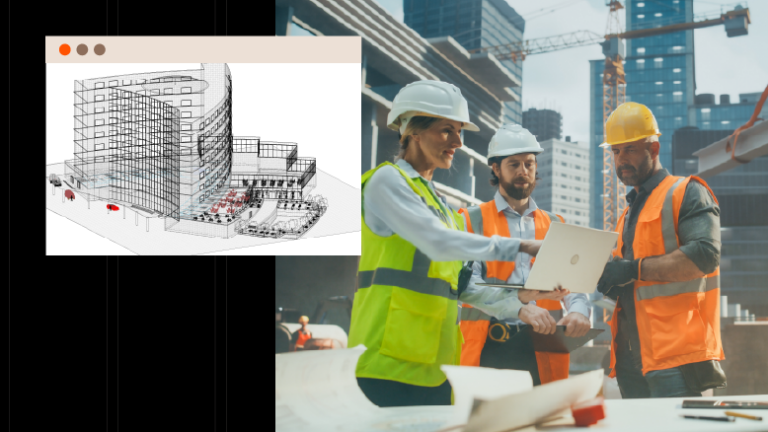— 8 min read
How BIM Software Supports Construction Teams in the Field

Last Updated Sep 23, 2025

Kristen Frisa
Contributing Writer
111 articles
Kristen Frisa is a contributing writer for Procore. She also contributes to a variety of industry publications as a freelance writer focused on finance and construction technology. Kristen holds a Bachelor of Arts in Philosophy and History from Western University, with a post-graduate certificate in journalism from Sheridan College. She lives in Ontario, Canada.
Last Updated Sep 23, 2025

Gaps between project design and field execution can cost a lot of money. Architects can create beautiful designs, but if the foreperson and trade crews don’t have access to the latest information, they’ll struggle to execute. This can cause communication breakdowns, inefficient work strategies and even costly rebuilds.
Building information modeling (BIM) software helps bridge the gap. It can provide design clarity and coordination on the ground, improve worker efficiency — and help teams avoid expensive mistakes.
Table of contents
What is BIM software?
BIM software is a platform that hosts BIM (Building Information Modeling), providing teams with easy access to view the digital model and the information contained within it. BIM software allows supervisors and superintendents to plan work more efficiently, see potential problems, reference new design changes in real-time, and view
BIM modeling software can also be useful to architects and VDC teams. It helps designers create 3D models with powerful simulation and building tools that are accessible from anywhere on smartphones and tablets.
Visualization
It provides realistic visualizations of the construction project, which helps stakeholders understand the design and identify potential issues early in the process.
Collaboration
BIM facilitates collaboration among architects, engineers, contractors and clients by providing a centralized platform where all stakeholders can access and update project information in real time.
Clash Detection
BIM clash detection software can identify clashes between different building systems (e.g., plumbing and electrical), allowing for resolution before construction begins, thus saving time and reducing costs.
When problems are caught in the virtual environment, they’re easier and less expensive to fix. As a result, projects can save time and money by deploying BIM clash detection.
This is particularly useful in the modern era of construction where schedules have become especially aggressive. In fact, when stakeholders argue that they don’t have time to perform BIM modeling, that project might need it more.

DJ Phipps
Senior Principal Strategic Product Consultant
Procore Technologies
Scheduling (4D BIM)
4D BIM is an animated construction schedule. This could be a video or a series of stills that show the project moving forward step by step. By adding time, scheduling and logistics data to the model, this added BIM dimension allows people to see and engage with the schedule in a new way.
Cost Estimation (5D BIM)
5D BIM, or cost estimation with BIM, helps in creating more accurate cost estimates by linking the 3D model with cost data, providing insights into the financial aspect of the project.
Facility Management
Post-construction, BIM models serve as valuable tools for facility management, offering detailed information about the building’s systems and components.
How Teams Use BIM on the Jobsite
BIM software helps employees at every level of operations work more efficiently. Superintendents, PMs and team supervisors leverage BIM to understand system layouts and verify installation details. This is especially helpful for representing detailed 3D models of mechanical, electrical and plumbing (MEP) components.
Project Planning
PMs use BIM to plan the construction process, ensuring that all components are correctly sequenced and that resources are allocated efficiently.
Risk Management
By utilizing BIM for clash detection and scenario planning, PMs can identify and mitigate potential risks before they impact the project timeline or budget.
For any particular risk you might have, you’re probably going to be able to, in some way, mitigate it through the use of a 3D model because you're affecting your process. By improving your process, hopefully you're going to be mitigating your risk.

Connor Christian
BIM Operations Manager
Kiewit
Communication
BIM enhances communication among the project team and stakeholders by providing a clear and comprehensive visual representation of the project, facilitating better decision-making.
Progress Monitoring
PMs use BIM to track the progress of construction activities against the schedule, allowing for timely adjustments and ensuring the project stays on track.
Change Management
Any changes to the project design or schedule can be quickly updated in the BIM model, ensuring that all parties are working with the most current information.
Quality Control
BIM helps PMs maintain high quality standards by providing detailed specifications and ensuring that construction aligns with the design intent.
One of the clearest ways that BIM supports field teams may actually be the difference it makes during design and preconstruction. By laying out a 3D visualization of the project, any potential clashes can be identified and fixed. It takes some vision and experience for teams to recognize the difference it makes to avoid clashes. However, anticipating these challenges can help avoid very costly errors and rework from happening in the field.
Free AI in Construction Course with Hugh Seaton
Start learning today with industry expert Hugh Seaton and discover how AI can boost efficiency, reduce risk, and transform your projects.

How BIM Software Improves Accuracy and Reduces Rework
BIM software reduces guesswork in the field by giving teams an easier way to verify correct placements before installation. It’s also a single platform that coordinates work between different trades, helping to avoid the kinds of overlaps and scheduling conflicts that can derail a construction timeline. These benefits collectively contribute to overall gains in accuracy and efficiency.im
Mobile Access: Bringing BIM to the Field in Real Time
BIM is powerful because it allows field teams to access real-time models. With a simple tablet and mobile app, a foreperson will be able to interact with models on site, view critical details at the point of installation and perform walkthroughs with visual aids to improve their assessments.
Plus, when somebody finds a problem, they can use BIM software on their phone to fix it while still in the field. This can save many trips back to the office by giving the whole team the tools it needs to collaborate effectively in real time.
BIM provides a clear understanding to project managers and superintendents about exactly where progress stands. Teams track project progress not because the whole project has suddenly gone off the rails, but because there are always areas of projects that could be trending towards getting off track.
Traditionally, managers would wait for pay applications to come in from trades to fully understand where the project stands. Using BIM, teams can walk the job site, identifying which tasks are done and which aren’t and compare that to a database, to get real-time data. Being able to accurately progress the project in a proactive manner allows the team to become more agile to course correct.
How Augmented Reality Boosts BIM Software's Field Capabilities
Pairing augmented reality (AR) with BIM is helping transform virtual design from a desk-bound activity to a dynamic, in-field experience.
This technology overlays digital information directly onto a user's real-world view. For example, pointing a phone at a wall can reveal existing installations alongside renderings of what still needs to be placed. Crews can visualize hidden elements, like ductwork behind a ceiling, by pulling data directly from the BIM.
Combining AR with BIM brings the detailed model directly into the field. Users instantly grasp design intent and planned installations. The AR overlay merges "as-built" conditions with future plans, providing a clear understanding of what needs to happen where.
Using AR in the field largely started with phones and tablets. The device’s camera took in the real world and fed it back to the user, laying the AR data over the top.
More sophisticated technology allows this same information overlay while keeping the user hands-free. Today, some companies leverage headsets that project the AR overlay within a clear visor. This can increase safety because the user is looking at the world around them, not at a device. As they move through the space, the AR information stays accessible, but the risk of missing a nearby hazard goes down.
DJ Phipps
Senior Principal Strategic Product Consultant
Procore Technologies
Strengthening Collaboration Between Field and VDC Teams
Teams also leverage BIM software to improve communication between field teams and in-office designers. These platforms strengthen collaboration by:
- Allowing VDC teams to push real-time updates directly to field users
- Allowing field teams to report issues and provide input with no external communication requirements
- Speeding up the conflict resolution process by eliminating paper plans and email threads
- Creating an ongoing feedback loop that brings VDC teams and field staff closer together
BIM can be really advantageous for understanding and communicating necessary changes between field and office.
BIM helps individuals visualize and understand systems to better identify and communicate project changes and run a model of resulting cost implications. It can help people visualize the field better by translating 2D plans into 3D images, so they can digest required changes. BIM can also quickly highlight changes between two plans to get a fast and accurate idea of costs.
Empower field teams with the right BIM tools.
Investing in BIM technology can substantially improve job site efficiency. But not all platforms are equal: Some do a better job of helping teams leverage the benefits of this technology than others. For example, some BIM software solutions can integrate with the other business apps a team uses, which can reduce communication delays and turn the platform into a single source of truth.
Some teams also prioritize tools based on customer service and training resources. For example, a team may want to make sure it has access to 24/7 support from software experts or access to on-demand videos for training new employees.
Bringing BIM software's full power out to the jobsite was once far more difficult, facing hurdles from limited technology access to a scarcity of skilled users. Fortunately, these obstacles are quickly disappearing as more of the industry embraces technology. The real challenge now involves companies dedicating time to train field teams in new workflows that maximize BIM's potential — empowering them to succeed and creating more organized and efficient jobsites.
Was this article helpful?
Thank you for your submission.
0%
0%
You voted that this article was . Was this a mistake? If so, change your vote
Scroll less, learn more about construction.
Subscribe to The Blueprint, Procore’s construction newsletter, to get content from industry experts delivered straight to your inbox.
By clicking this button, you agree to our Privacy Notice and Terms of Service.
Thank you!
You’re signed up to receive The Blueprint newsletter from Procore. You can unsubscribe at any time.
Categories:
Written by

Kristen Frisa
Contributing Writer | Procore
111 articles
Kristen Frisa is a contributing writer for Procore. She also contributes to a variety of industry publications as a freelance writer focused on finance and construction technology. Kristen holds a Bachelor of Arts in Philosophy and History from Western University, with a post-graduate certificate in journalism from Sheridan College. She lives in Ontario, Canada.
View profileExplore more helpful resources

How Are Partnerships in Construction Being Redefined?
In a market where cost, speed, and quality are table stakes, owners are demanding more than projects delivered on time and on budget. They want trusted partners who bring strategy,...

How Close Are We to Bridging the Design-Build Divide?
For decades, construction decisions have often been made based on gut instinct. But what if the real barrier to transformation isn’t technology—it’s the divide between design and construction? In episode...

Will AI Replace ‘Paperless Builders’—or Redefine Them?
How can artificial intelligence enhance rather than replace human expertise in construction? In Episode 16, Hamzah Shanbari, Director of Innovation at Haskell and author of “The Paperless Builders,” reveals how...

Building Intelligence: How AI & Data Are Rewiring Construction for the Digital Age
As data center construction surges to meet the demands of AI, cloud computing, weekend streaming binges and real-time digital services, the pressure being put on builders by owners has reached...
Free Tools
Calculators
Use our calculators to estimate the cost of construction materials for your next project.
Templates
Find a template to help you with your construction project tasks.
Material Price Tracker
Get the latest U.S. retail prices and view historical trends for common building materials.
Glossary
Explore key terms and phrases used in the industry.
